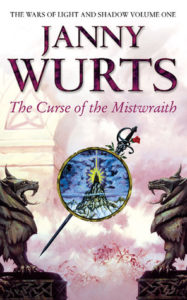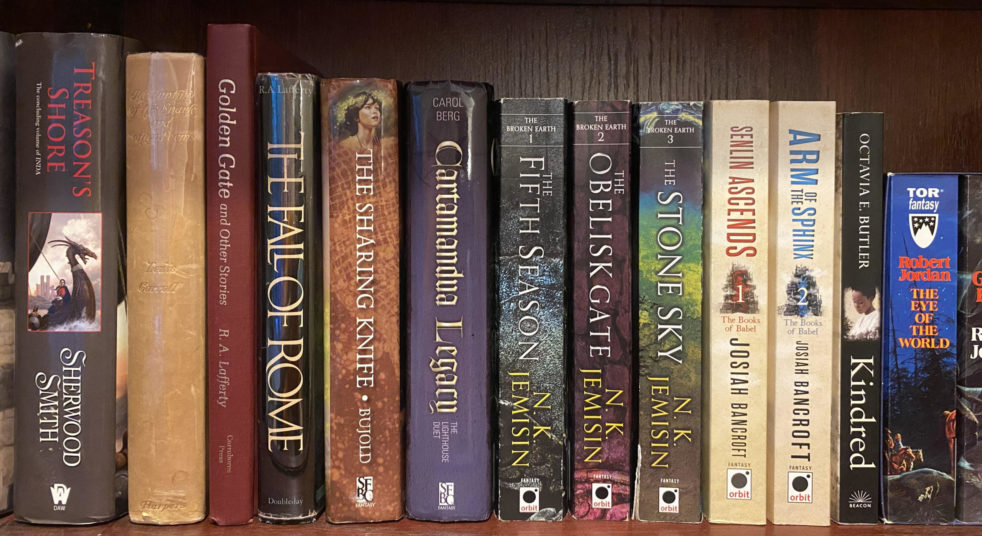
I like big, chunky epic fantasies. I grew up on Shannara, and The Wheel of Time remains an all-time favorite. But the longer my TBR gets, the more I feel the opportunity costs of starting a doorstopper, and the more I gravitate towards shorter books. Which is why, despite having enjoyed her other work, and despite hearing a number of recommendations for the epic Wars of Light and Shadow, it took a long time for me to actually pull Janny Wurts’ The Curse of the Mistwraith off my shelf. As may be a common theme if you read a lot of my reviews, it was an online readalong that did it. So how did it go?
The Curse of the Mistwraith is about as epic as epic can be, with an introduction promising a continent-spanning war drawn out over five centuries and an 800-page opener that just scratches the surface of the story that will come over the next ten books. If you don’t like epic fantasy, don’t pick it up. But if you do, there’s plenty to hook you in from the literal first page, in which the prologue tells of the epic wars of light and shadow, how they may not have really gone as popularly believed, and how expert seers have been employed to capture the real story, as it happened. And so kicks off the story of Arithon and Lysaer, half-brothers from another world, destined to be at the center of conflict that will shape the land of Athera for centuries.
Janny Wurts has a reputation for dense prose, and that can be an obstacle to getting into the story if it isn’t your preferred style. Personally, I prefer something roughly halfway between the spartan and flowery extremes, but I didn’t have any issue with her standalone epic thriller To Ride Hell’s Chasm. But The Curse of the Mistwraith leans even farther into the more formal-sounding high fantasy style, and there are so many bits of background communicated over the opening novel that it can be slow going. A steady stream of background is preferable to large infodumps, but combined with a prose style aiming at poetry, it makes this a book that you absolutely cannot speed read.
But if you enjoy a more intricate prose that forces you to take your time, Wurts has a pretty good story to tell you. There are two intertwined main plots: the struggle to banish the titular mistwraith, and two half-brothers—Lysaer and his inborn power over light, Arithon and his power over shadow—growing into the figures that will stand at the heart of the conflict for an entire continent. It’s a big world and a big book, and plenty of other conflicts arise over the course of the series opener, with dangerous creatures to fight, separate factions of mages with very different outlooks on the handling of the brothers, magical races to be brought back from long exile, et cetera. But the power of these smaller conflicts is directly proportional to how tightly they connect to the building long-term story of Lysaer and Arithon. There are encounters that just don’t muster the desired stakes because they’re too peripheral to the main story, even if they might reveal some background about the world or characters. But others feel like stage-setting for major developments to come.
To be clear, while every epic opener has plenty of stage-setting, The Curse of the Mistwraith has enough shorter arcs to be worth the price of admission. The struggle against the mistwraith itself has world-level stakes, and while Lysaer and Arithon may have plenty more story to come, both characters develop significantly over the course of one book. The prologue practically screams “deconstruction of the hero of the light,” and both characters grow in ways that are always interesting, not always positive, and absolutely not the expected path for fantasy heroes. Those changes really form the emotional heart of the book, and both Lysaer and Arithon’s arcs deliver meaningful—and at times heart-wrenching—progression while also setting up a fascinating dynamic for the remainder of the series. It was the characters that kept me invested even though the prose style isn’t quite in my wheelhouse, and it’s the characters that make this worth a look for fans of epic fantasy.
Recommended if you like: expansive epics, densely poetic prose, heroic subversions.
Can I use it for Bingo? If you read at least a page of the glossary, the mass-market paperback is 800+ Pages, and I’d argue it’s hard mode for Revenge. It also is a Book Club book, has Chapter Titles, and is on the A-Z Genre Guide.
Overall rating: 15 of Tar Vol’s 20. Four stars on Goodreads.
